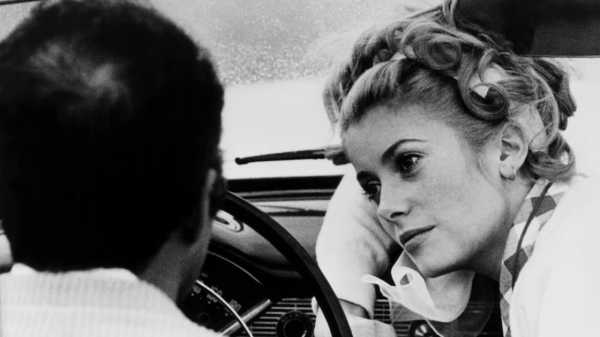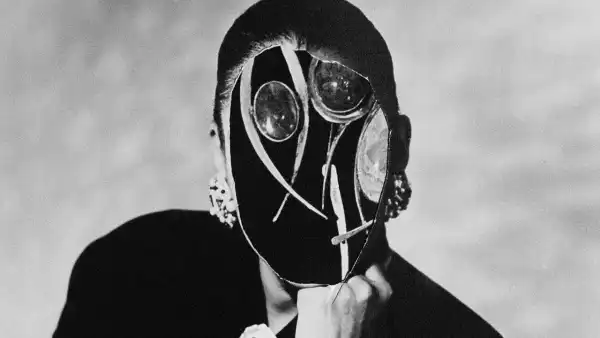
There’s a retrospective of the actor Michel Piccoli taking place at Film
Forum right now, and another, of the director Agnès Varda,
that will alight at Museum of the Moving Image this weekend, but the
movie in which the twain first met is nowhere to be seen in either. Varda’s “Les Créatures,” the science-fiction romance, from 1966,
starring Piccoli and Catherine Deneuve, which, to the best of my
knowledge, hasn’t been shown in New York City in a long time and is
unavailable on DVD or to stream. I called attention to its absence
recently in an IndieWire survey;
now I’ve seen it, and can affirm that, on the basis of artistic quality,
audacity, and inventiveness, the absence of this movie—Varda’s fourth
feature—is all the more regrettable.
“Les Créatures” (The Creatures) is yet another reminder that film
history is subject to the vagaries of availability and that work by great women filmmakers is all too often written out of it. In the early nineteen-sixties, when François Truffaut was planning to make his adaptation of Ray Bradbury’s novel “Fahrenheit 451,” he worried that French filmmakers didn’t do science fiction well. Varda’s film, which came out in France two weeks before Truffaut’s, proved his
hesitations wrong exactly as his own film did. Above all, no less than
Truffaut, Varda transformed science fiction into a subject in her own
image—she did so even more radically and more personally, and the
extremes of her ideas may be exactly why “Les Créatures” has wrongly
fallen by the wayside of film history.
Varda’s film—dedicated to “Jacques” (likely Jacques Demy, the late
director, who was her husband)—is filmed on the island of Noirmoutier,
where the couple had a home. The island is one of the subjects of her
sublime cinematic self-portrait “The Beaches of Agnès”; here, too, Varda
dramatizes the way the island’s residents are seen, through the eyes and
in the imagination of an artist. “Les Créatures” is centered on a
couple, Edgar Piccoli (Piccoli), who’s a novelist, and his wife, Mylène
(Deneuve). They’re in a car en route to the island. Edgar is driving too
fast; Mylène asks him to slow down. He says that when the car goes fast,
his ideas come fast, but, instead, the car crashes, leaving Edgar with a
gash on his forehead and Mylène unable to speak (though she’s in full
possession of her faculties).
There’s a gradual exposition in which Mylène, like a princess in a
castle, remains in the so-called fort where the couple lives (soon after
they arrive, she discovers that she’s pregnant) and Edgar, who’s busy
writing about his fictional characters (whom he calls his “creatures”),
wanders through town running errands. There, he encounters a wide range
of inhabitants whose harsh mores, petty venality, amiable frivolity, and
furtive intimacies come anecdotally to the fore. But a few of the
residents are involved in a subtle scheme in which they slip a small
metal disk into someone’s pocket or parcel, and a kind of demonic
mind-possession results—the movie’s black-and-white images are tinted
blood-red, and the bearer goes on a brief rampage of cruelty. Edgar
decides to investigate, and his snooping leads him to the tower of the
solitary engineer, Ducasse (Lucien Bodard), who brazenly displays his
diabolical scheme. (Ducasse is, of course, the family name of the
short-lived writer Lautréamont, who was also trained as an engineer,
whose work was obsessed with evil, and one of whose books Mylène is seen
reading.)
Ducasse’s laboratory features several television screens; a switchboard
of sockets, plugs, and cords; and a chessboard without pieces. When
Edgar challenges the engineer about his machinations, Ducasse makes him
an offer—to play a chess-like game with him. If Edgar wins, Ducasse will
end his mind-control scheme; if Ducasse wins, Ducasse will “destroy”
Mylène. This chess-like game is a cinematic inspiration of an ecstatic,
straight-faced giddiness: Edgar selects playing cards from a deck
featuring images of the town’s residents; as he turns the cards over,
homunculus-like versions of each resident take their place on the
chessboard in lieu of pieces. Ducasse rolls a die to control the number
of steps that each character takes, and presses switches to make them
move on the board—and in real life.
What they do (or rather, the actions that they take as forced by Ducasse
or resisted by Edgar) is visible on the laboratory’s television sets.
These films-within-the-film are like fictionalized documentaries of life
in Noirmoutier, but documentaries that unfold under the battle for
mind-control between the evil Ducasse and the virtuous Edgar. It’s not
giving away too much to say that the pivot of the action is Edgar’s
discovery, on Ducasse’s televisions, that a respected old man in the
village is a serial sexual predator who attacks teen-age girls.
In effect, Varda turns the blend of fantasy and realism into a wild
science-fiction-plus-neo-realist parody of Ingmar Bergman’s “The Seventh
Seal”—a target that is all the more apt because “Les Créatures” is a
French-Swedish co-production and one of the townspeople is played by Eva
Dahlbeck, a frequent Bergman collaborator. (What’s more, the game of
self-referential casting is amped up by the presence of Nino
Castelnuovo, who starred with Deneuve in Demy’s film “The Umbrellas of
Cherbourg,” from 1964.)
“Les Créatures” is as imaginative as it is playful, as fanciful as it is
frank, as intimately personal as it is wide-ranging. It’s a
science-fiction film that uses the devices and the conventions of the
genre to tell stories of marriage and art, of evil imaginings and evil
doings, that would have been hard to tell in a plainer and less
elaborately constructed cinematic framework. It may well be its subjects
as well as its styles that have resulted in its virtual suppression.
It’s just one in a vast list of reminders that the history of cinema
remains to be discovered—and that, as a result, the future of the art is
advancing blindfolded.
Sourse: newyorker.com






